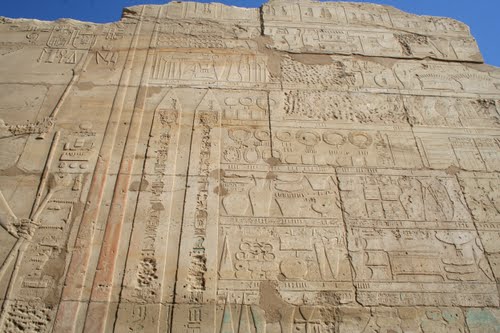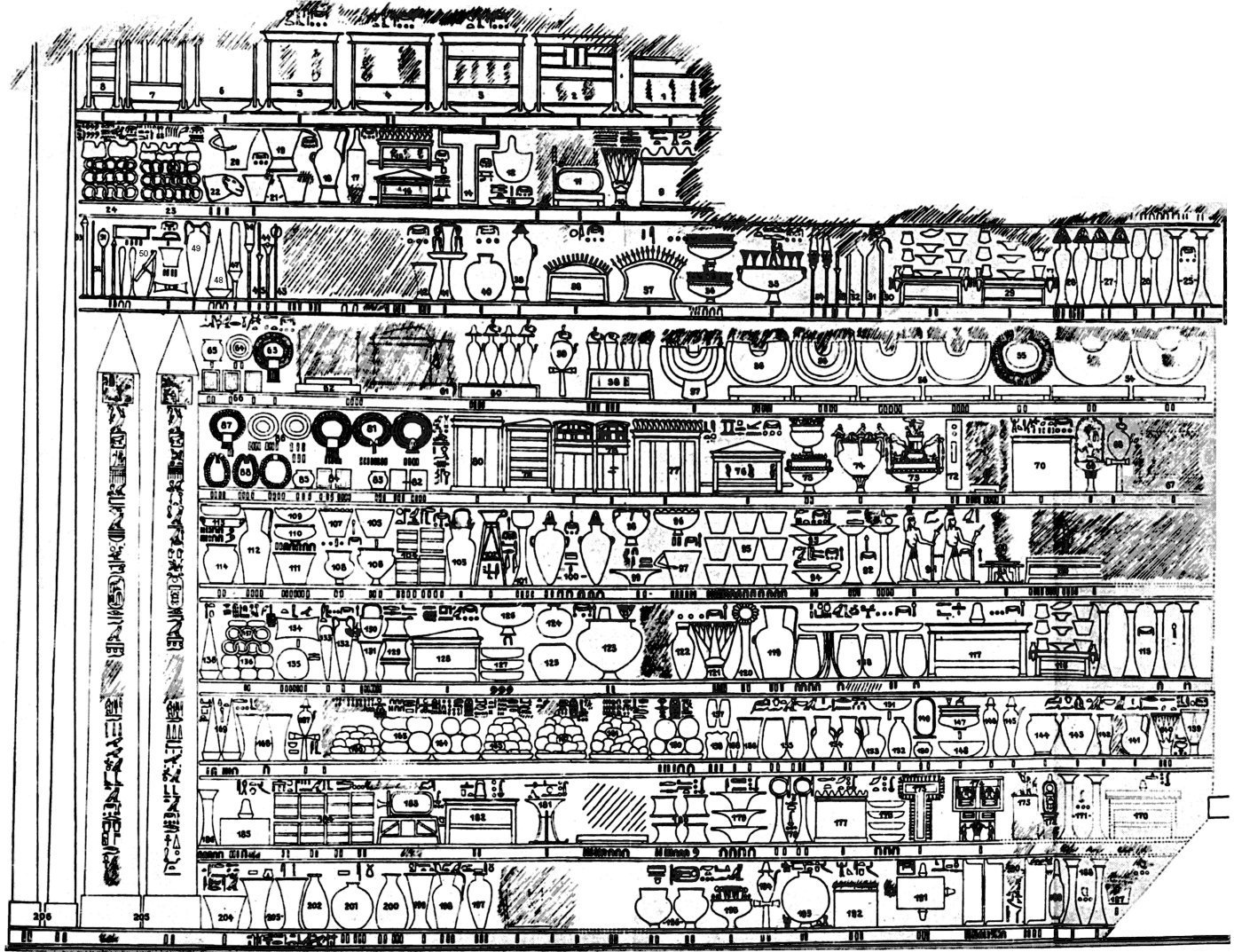Thutmose III
King Tuthmos The 3rd Egypt's - National Geographic
Pharaoh Thutmose III and the Battle of Megiddo Click Here
Pharaohs Thutmose III At War
The Utensils of Solomon's Temple
Drawing by W./ Wreszinki of the Bas Relief - for clearer identification of the items.
Walter Wreszinki - Education
He studied in Leipzig from 1898 to 1899, then in Berlin from 1899 to 1904 (under Adolf Erman). During this period he worked on the Dictionary of the Egyptian language.In Berlin, he graduated in 1904 with a dissertation on The High Priest of Amon.Following his graduation, he moved to Königsberg in 1909, initially as a lecturer, then from 1920 as honorary associate professor, and from 1927 as associate professor. From 1921 to 1931 Wreszinski was editor of the Orientalist literature journal. In 1934, after the Law for the Restoration of Civil Service was passed by the Nazi Party led government, Wreszinski lost his professorship by reason of his Jewish ancestry.
Shishak Plunders Solomon's Temple
(The Elephant in the Room)
"And it came to pass, that in the fifth year of King Rehoboam, Shishak, king of Egypt came up against Jerusalem, because they had transgressed against the LORD... So Shishak king of Egypt... took away the treasures of the house of the LORD, and the treasures of the king's house..." (2 Chronicles 12:2,9)
Anyone who has visited or studied "Ancient Egypt" is familiar with the Karnak Temple at Luxor, in Thebes, Egypt. Much of the history of the Eighteenth Dynasty is engraved on the walls and columns of the Temple Complex.
Akhenaton - Amenhotep IV
Queen Hatshepsut of Egypt
HATSHEPSUT: The Queen Who Would Be King (History
Documentary featuring Bob Brier)
Who was Champollian? Who was Queen Hatshepsut?
Click Here for this informative Video
***********************************************************************************************
Queen Hatshepsut – The Pharaoh Who Conquered the Sea
Watch this fascinating video of archeologists who build a replica of Qukeen Hatshepsut's ships shown in Bas Relief at the Deir El Bahari Temple and Complex:
For educational purpose only all credits to BBC
Over 3,000 years ago legend has it that Queen Hatshepsut, Egypt's first female pharaoh, sent a fleet of ships to the wonderful, distant land of Punt. A bas-relief in the temple where she is entombed in Luxor shows them bringing back extraordinary treasures. But did this expedition really happen? And if it did, where exactly is the land of Punt?
Drawing upon recent finds, archaeologist Cheryl Ward sets out to recreate the voyage in a full-size replica of one of these ancient ships, sailing it in the wake of Hatshepsut's fleet in search of the mythical land of Punt. A human adventure as well as a scientific challenge, the expedition proves that, contrary to popular belief, the ancient Egyptians had the necessary tools, science and techniques to sail the seas.
-



"...a command was heard from the great throne, an oracle of the god hmself, that the ways to Punt should be searched out, that the highways to the myrrh-terraces should be penetrated"
" I will lead the army on water and on land, to bring marvels from God's land for this god, for the fashioner of her beauty..." (Breasted, Records, Vol. II, Sec. 285)
"I have led them (the company of the expedition) on water and on land, to explore the waters of the inaccessible channels, and I have reached the myrrh-terraces." (Breasted, Records, Vol. II, Sec. 288)
Punt Reliefs:" I have reached the myrrh-terraces. It is a glorious region of God's land" (Breasted, Records, Vol II, Sec. 288.)
Chronicles II -9:11 - "And the king made of the algum trees terraces to the house of the Lord, and to the king's palace...and there were none such seen before in the land of Judah."
Josephus:" And the king received her gladly on her arrival and was studious to please her in all ways, in particular by mentally grasping with ease the ingenious problems she set him. "(Jewish Antiquities, VIII, 167. )
When the queen saw the palace of the king, "and the sitting of his servants, and the attendance of his ministers, and their apparel, and his cup bearers, and his ascent by which he went up into the house of the Lord, there was no more spirit in her" (I Kings 10:4-5)
Punt Reliefs: "(She praised) the greatness of the marvels, which happened to her. Never did the like happen under any gods who were before, since the beginning." (Breasted, Records, Vol. II, Sec 274)
Punt Reliefs:" It was heard of from mouth to mouth by hearsay o f the ancestors...."
I Kings 10:6-7:" And she said to the king, It was a true report that I heard in mine own land of thy acts and of thy wisdom. Howbeit I believed not the words, until I came, and mine eyes had seen it, and behold, the half was not told me; thy wisdom and prosperity exceedeth the fame which I heard."
"King Solomon exceeded all the kings of the earth for riches. (The land seemed to the queen an abode of happy men.) Happy are thy men, happy are these thy servants...Blessed be the L-rd thy G-d" (I Kings 10:8-9)
Punt Relief: "It is a glorious region of G-d's Land. It is indeed my place of delight...I conciliated them by love that they might give to thee praise."
Queen of Sheba: "because the L-rd loved Israel for ever, therefore made thee king..."(I Kings 10:9)
Punt Relief:"because he (Amon) so much loves the King of Upper and Lower Egypt, Hatshepsut..."
"And she gave the king a hundred and twenty talents of gold, and of spices great abundance, and precious stones" (II Chronicles 9:)
"And King Solomon gave to the queen of Sheba all her desire, whatsoever she asked..."
for more, see: Immanuel Velikovsky, Ages in Chaos, volume I: From the Exodus to King Akhnaton, (pp. 104-141.)
Was Hatshepsut the QUEEN OF SHEBA?
Was Hatshepsut the QUEEN OF SHEBA — or Merely the Queen of Theba?
Emmet Sweeney
In my 2006 book Empire of Thebes: Ages in Chaos Revisited I argued that most of the synchronisms and character identifications proposed by Immanuel Velikovsky in his Ages in Chaos (1952) were actually correct, and that the errors committed by him — which the critics made so much of — were of a relatively minor nature. Ages in Chaos, in short, needed fine-tuning, not complete rejection. Indeed, Velikovsky missed a great deal of evidence in his favor. This was the case, for example, with the equation of Hatshepsut with the Queen of Sheba.
In Ages in Chaos Velikovsky argued that the Eighteenth Dynasty rose to power at the same time as the kingdom of Israel, and that the first pharaohs of that line, Ahmose and Amenhotep I, were contemporaries of Israel’s first two kings, Saul and David. About thirty years after the war of liberation, Egypt came to be ruled by Hatshepsut, an extraordinary woman, one who, unique in the annals of Egypt’s history, claimed the honor and title of Pharaoh. In Velikovsky’s system, Hatshepsut must have been a contemporary of Solomon, the fabulously wealthy and powerful son of King David. For Velikovsky, it was but a short step from placing Hatshepsut at the same time as Solomon to making her identical to Solomon’s famous royal visitor, the Queen of Sheba. READ MORE
- ga('create', 'UA-80586836-1', 'auto');
ga('send', 'pageview');
The Egyptian Dynasties
Dynasties This list is incomplete. Pharaohs are missing or have been left out above all in the lists of the Early and the intermediate Periods. All the dates until the Late Period should be taken with a grain of salt, some think a good deal more than just a grain. |
|||
| Predynastic Period | c.3500-3100 BCE | ||
| Early Dynastic Period | c.3100-2686 BCE | ||
| 'Scorpion' Narmer |
|||
| 1st Dynasty | c.3100-2890 BCE | ||
| Menes (Hor-Aha) Djer Wadj (Djet) Den Anendjib Semerkhet Qa'a |
|||
| 2nd Dynasty | c.2890-2686 BCE | ||
| Hotepsekhemwy Raneb Nynetjer Seth-Peribsen Khasekhemwy |
|||
| Old Kingdom | c.2686-2181 BCE | ||
| 3rd Dynasty | c.2686-2613 BCE | ||
| Sanakhte (Nebka) (c.2688-2668) Djoser (Netjerikhet) (c.2668-2649) Sekhemkhet (Djoser Teti) (c.2649-2641) Khaba (c.2641-2637) Huni (c.2637-2613) |
|||
| 4th Dynasty | c.2613-2494 BCE | ||
| Snofru (c.2613-2589) Khufu (Cheops) (c.2585-2566) Djedefre (c.2566-2558) Khafre (Rekhaf) (c.2558-2532) Menkaure (Mykerinos) (c.2532-2514) Shepseskaf (c.2514-2494) |
|||
| 5th Dynasty | c.2494-2345 BCE | ||
| Userkaf (c.2494-2487) Sahure (c.2487-2475) Neferirkare Userkhau (c.2475-2455) Shepseskare (c.2455-2448) Raneferef (c.2448-2445) Niuserre (c.2445-2421) Menkauhor (c.2421-2413) Djedkare (c.2413-2381) Unas (Wenis) (c.2381-2345) |
|||
| 6th Dynasty | c.2345-2181 BCE | ||
| Teti (c.2345-2313) Pepi I Meryre (c.2313-2279) Merenre (c.2279-2270) Pepi II Neferkare (c.2279-2181) |
|||
| First Intermediate Period | c.2181-2040 BCE | ||
| 7/8th Dynasty | c.2181-2173 BCE | ||
| Wadjkare Qakare Iby |
|||
| 9/10th Dynasty | c.2160-2040 BCE | ||
| Meryibre Kheti (Akhtoy) I Merykare Kanrferre Nebkaure Kheti (Akhtoy) II Wahkare Kheti (Akhtoy) III Merikare |
|||
| 11th Dynasty | c.2133-1991 BCE | ||
| Intef I (Inyotef I) Sehertawy (c.2133-2123) Intef II (Inyotef II) Wahankh (c.2123-2074) Intef III (Inyotef III) Nakhtnebtepnefer (c.2074-2066) Mentuhotep I ? (c.2066-2040) |
|||
| Middle Kingdom | c.2040-1786 BCE | ||
| 11th Dynasty | |||
| Mentuhotep II Nebhepetre (c.2040-2010) Mentuhotep III Sankhkare (c.2010-1998) Mentuhotep IV Nebtawyre (c.1998-1991) |
|||
| 12th Dynasty | c.1991-1786 BCE | ||
| Amenemhet I Sehetepibre (c.1991-1962) Senusret I Kheperkare(c.1962-1917) Amenemhet II Nubkaure (c.1917-1882) Senusret II Khakhperre (c.1882-1878) Senusret III Khakaure (c.1878-1841) Amenemhet III Nimaatre (c.1841-1796) Amenemhet IV Maakherure (c.1796-1790) Queen Sobeknerfu Neferusobek (c.1790-1786) |
|||
| Second Intermediate Period | c.1786-1567 BCE | ||
| 13th Dynasty (about 70 kings) | c.1786-1633 BCE | ||
| Wegaf Khawitawire (c.1783 - 1779) Amenemhet V Sekhemkare Harnedjheriotef Hetepibre Sobekhotep I Khaankhre (ca.1750) Hor Amenemhet VII Sedjefakare Sobekhotep II Sekhemre-Khutawy (ca.1745) Khendjer Sobekhotep III Neferhotep I Khasekhemre (c.1723-1713) Sobekhotep IV Merihotepre Khaneferre (c.1713) Iaib (c.1713-1703) Ay Merneferre (c.1703-1680) Neferhotep II and eight more kings |
|||
| 14th Dynasty | c.1786-1603 BCE | ||
| Nehesy | |||
| 15th Dynasty | c.1674-1567 BCE | ||
| Hyksos kings Semqen ? Aper-Anati ? Sakir-Har Khyan (Apachnan) Apepi I (Apophis) Apepi II (Khamudi?) (c.1542-1532) |
|||
| 16th Dynasty | c.1684-1567 BCE | ||
| Hyksos kings ? ? |
|||
| 17th Dynasty | c.1650-1567 | ||
| Sobekemsaf I Sekhemre Wadjkhau Sobekemsaf II Intef VII Tao I Seakhtenre Tao II Sekenenre Kamose Wadjkheperre |
|||
| New Kingdom | c.1570-1070 BCE | ||
| 18th Dynasty | c.1570-1293 BCE | ||
| Ahmose I Nebpehtyre (c.1570-1546) Amenhotep I Djeserkare (c.1546-1527) Thutmose I Akheperkare (c.1527-1515) Thutmose II Akheperenre (c.1515-1498) Queen Hatshepsut Maatkare (c.1498-1483) Thutmose III Menkhepere (c.1504-1450) Amenhotep II Akheperure (c.1450-1412) Thutmose IV Men-khepru-Re (1412-1402) Amenhotep III Nebmaatre (c.1402-1364) Amenhotep IV/Akhenaten Neferkheperure (c.1350-1334) Smenkhkare Ankhheperure (c.1334) Tutankhamen Nebkheperoure (c.1334-1325) Ay Kheperkheperure (c.1325-1321) Horemheb Djeserkheperure (c.1321-1293) |
|||
| 19th Dynasty | c.1293-1185 BCE | ||
| Ramses I Menpehtyre (c.1293-1291) Seti I Merienptah Menmaatre (c.1291-1278) Ramses II Meriamen Usermaatre Setepenre (c.1279-1212) Merneptah Hetephermaat Baenre Meriamen (c.1212-1202) Amenmes Heqawaset Menmire Setepenre (c.1202-1199) Seti II Merenptah Userkheperure Setepenre (c.1199-1193) Merneptah Siptah Sekhaenre/Akhenre (c.1193-1187) Queen Twosret Setepenmut Sitre Meriamen (c.1187-1185) |
|||
| 20th Dynasty | c.1185-1070 BCE | ||
| Sethnakhte Userkhaure Setepenre (c.1185-1182) Ramses III Usermaatre Meriamen (c.1182-1151) Ramses IV Usermaatre/Heqamaatre-Setepenamen (c.1151-1145) Ramses V Usermaatre Sekheperenre (c.1145-1141) Ramses VI Nebmaatre Meriamen (c.1141-1133) Ramses VII Usermaatre Setepenre Meriamen (c.1133-1128) Ramses VIII Usermaatre Akhenamen (c.1128-1126) Ramses IX Neferkare Setepenre (c.1126-1108) Ramses X Khepermaatre Setepenptah (c.1108-1098) Ramses XI Menmaatre Setepenptah (c.1098-1070) |
|||
| Third Intermediate Period | c.1070-664 BCE | ||
| High Priests (Thebes) Contemporaries of the 21st dynasty at Tanis |
|||
| Herihor Siamun Hemnetjertepyenamun (c.1080-1074) Piankh (c.1074-1070) Pinedjem I Meriamen Khakheperre Setepenamun (c.1070-1032) Masaherta (c.1054-1046) Djedkhonsefankh (c.1046-1045) Menkheperre (c.1045-992) Smendes II (c.992-990) Pinedjem II (c.990-969) Psusennes (c.969-959) |
|||
| 21st Dynasty Tanite |
c.1070-945 BCE | ||
| Nesbanebded Hedjkheperre Setepenre (Smendes I) (c.1070-1043) Nephercheres (Neferkare-hekawise Amenemnisu Meramun (c.1043-1039) Psusennes I Akheperre Setepenamun (c.1039-1000) Amenemope Usimare Setepenamun (c.1000-991) Osorkon the elder (Osochor) (c.991-985) Psinaches (c.985-976) Psusennes II Titkheprure (c.976-962) Siamun Nutekheperre Setepenamun Siamun Meramun (c.962-945) |
|||
| 22nd Dynasty Bubastite |
c.945-730 BCE | ||
| Sheshonq I Hedjkheperre Setepenre (c.945-924) Osorkon I Sekhemkheperre Setepenre (c.924–889) Sheshonq II Hekakheperre Setepenre (ca. 890) Takelot I Usimare (c.889–874) Osorkon II Usimare Setepenamun (c.874–850) Harsiese (ca. 865) Takelot II Hedjkheperre Setepenre (c.850–825) Sheshonq III Usimare Setepenamun (c.825–773) Pamai (c.773–767) Sheshonq V Akheperre (c.767–730) Osorkon IV (c.730–712) |
|||
| 23rd Dynasty Tanite |
c.817-730 BCE | ||
| Pedibastet Meriamen Usermaatre Setepenre(c.818–793) Iuput I (ca. 800) Sheshonq IV Usermaatre Meriamen (c.793–787) Osorkon III Usermaatre Setepenamen (c.787–759) Takelot III Usermaatre (c.764–757) Rudamon Usermaatre Setepenamen (c.757–754) Iuput II Meriamen sibastet Usermaatre (c.754–712) Nimlot (ca. 740) Peftjauabastet Nefer-ka-re (c.740–725) Thutemhat (ca. 720) Pedinemti (ca. 700) |
|||
| 24th Dynasty | c.720-714 BCE | ||
| Shepsesre Tefnakht (c.724-717) Wahkare Bakenrenef (c.717-712) |
|||
| 25th Dynasty | 747-656 BCE | ||
| Piye Usimare Sneferre (Piankhi) (747-716) Shabaka Neferkare Wahibre (716-702) Shebitku Djedkaure Menkheperre (702-689) Taharka Khunefertemr (689-663) Tanutamun Bakare (663-656) |
|||
| Late Dynastic Period | 664-332 BCE | ||
| 26th Dynasty | 664-525 BCE | ||
| Necho I (664-656) Psammetic I Wahemibre Psamtek (656-609) Necho II Wahemibre Neko (609-594) Psammetic II Neferibre Psamtek (594-587) Wahibre (Haaibre) (Apries) (587-569) Ahmose II Khnemibre (Amasis) (569-526) Psammetic III Ankhkaenre (526) |
|||
| 27th Dynasty | 525-404 BCE | ||
| Cambyses II (525-522) Darius I (521-486) Xerxes (486-465) Artaxerxes I (465-424) Darius II (423-405) Artaxerxes II (405-359) |
|||
| 28th Dynasty | 404-399 BCE | ||
| Amenirdis (Amyrtaeus) (404-399) | |||
| 29th Dynasty | 399-380 BCE | ||
| Nefaarud I (Nepherites I) (399-393) Psammuthis Userre Setepenptah Pasherienmut (ca. 392) Hakor Khnemmaere Setpenkhnum (Achoris) (392-380) Nefaarud II (Nepherites II) (380) |
|||
| 30th Dynasty | 380-343 BCE | ||
| Nakhtnebef Kheperkare (Nectanebo I) (380-362) Djedhor (362-360) Nekhtharehbe Snedjemibre Setpenanhur (Nectanebo II) (360-343) |
|||
| 31st Dynasty | 343-332 BCE | ||
| Artaxerxes III (343-338) Arses (338-336) Darius III (336-332) |
|||
| The Graeco-Roman Period | |||
| Macedonian Kings | |||
| Alexander the Great (332-323) Philip III Arrhidaeus (323-317) Alexander IV Aegus (317-311) |
|||
| Ptolemaic Dynasty | 323-30 BCE | ||
| Ptolemy I Soter (305-282) Ptolemy II Philadelphus (284-246) Arsinoe II (278-270) Ptolemy III Euergetes I (246-222) Bernice II (246-221) Ptolemy IV Philopator (222-205) Ptolemy V Epiphanes (205-180) Harwennefer (205-199) Ankhwennefer (199-186) Cleopatra I (194-176) Ptolemy VI Philometor (180-164) Cleopatra II (175-115) Ptolemy VII Neos Philopator (164-145) Ptolemy VIII Euergetes II (145) Cleopatra III (142-101) Ptolemy IX Soter II (116-80) Ptolemy X Alexander I (107-88) Ptolemy XI Alexander II (80) Ptolemy XII Neos Dionysos (80-51) Queen Bernice IV (58-55) Ptolemy XIII (51-47) Queen Cleopatra VII (51-30) Ptolemy XIV (47-44) Ptolemy XV (44-30) Footnotes: |
|||


